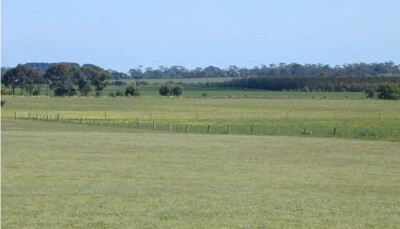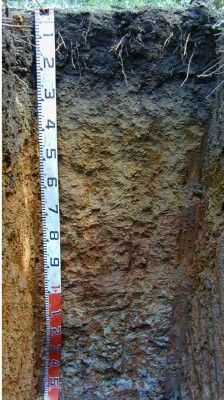MAN98 (Plot 2)
| Site: MAN98 (Plot 2) | Land Unit: Warrakbook Basalts |
| Aust. Soil Class.: | |
 | General Land Unit Description: This land unit consists of gently undulating basalt plains in the Macarthur area. In some drainage lines, the basalt has been dissected sufficiently to expose the underlying sediments. The soils on the basalt plains are commonly Brown Kurosols or Chormosols, intermixed with Sodosols, particularly on the lower slopes and drainage depressions. Two year old Eucalyptus globulus plantation on ex-agricultural land |
| Geology: Quaternary basalt | Landform pattern: |
| Position in landscape: | Internal drainage: Imperfectly drained |
Soil Profile Morphology
| A1 | 0-20 cm | Very dark greyish brown (10YR3/2) fine sandy clay loam; weak polyhedral structure (10-20 mm) parting to weak granular structure (2-5 mm); very weak consistence when moderately moist; many medium roots; clear and smooth transition to: |  |
| A2 | 20-35 cm | Dark yellowish brown (10YR4/4) fine sandy clay loam; weak polyhedral structure (10-20 mm) parting to weak granular (2-5 mm); very weak consistence when moist; very many medium ferruginous nodules; few very fine roots; abrupt and smooth transition to: | |
| Subsoil | |||
| B21 | 35-65 cm | Yellowish brown (10YR5/7) with few medium faint yellowsh red (5YR5/8) mottles, light medium clay; moderate polyhedral structure (20-50 mm) parting to moderate granular structure (5-10 mm); weak consistence when moist; few medium ferruginous nodules; common very fine macropores; areal porosity 0.3%; few very fine roots; diffuse and smooth transition to: | |
| B22 | 65-110 cm | Brownish yellow (10YR6/6) with many very coarse distinct red (2.5YR4/6) mottles, light medium clay; moderate polyhedral structure (20-50 mm) parting to moderate granular structure (5-10 mm); weak consistence when moist; few medium ferruginous nodules; common fine macropores; areal porosity 0.4%; few very fine roots; gradual and smooth transition to: | |
| B23 | 110-150 cm | Red (10YR7/1) with many very coarse red (2.5YR5/6) mottles, medium clay; strong subangular blocky structure (20-50 mm) parting to strong polyhedral structure (10-20 mm); weak consistence when moist; very few coarse ferruginous nodules; few fine macropores; areal porosity 0.03%; few very fine roots. | |
| 150-250 cm | Similar to above. | ||
| 250-350 cm | Heavy clay and weathered basalt rock (60-200 mm). No live roots observed but some old remnant roots were observed between 300-350 cm. | ||
| 350-420 cm | More rock than above, still some soil between rocks, no roots observed. |
Notes: Roots do not appear to readily penetrate through the gravelly A2 horizon.
Sampled by: Ian Sargeant, Paul Feikema, Martin Clark and Kiet Quach (30 October, 2000).


